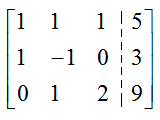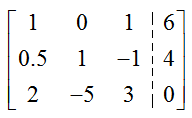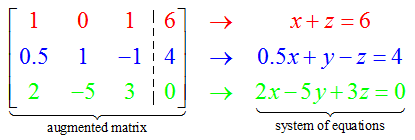How do you form an augmented matrix from a system of linear equations?
The entries in a matrix are not just random values without meaning. In general, the rows and columns in a matrix have labels that help you to match numbers with an application. For an augmented matrix, the rows in a matrix correspond to the equations in a system of linear equations. The columns match with the variables and constants in each equation. The augmented matrix that corresponds to the system of linear equations
is
For a system to be written as an augmented matrix, all of the variables in the system must be on one side of the equal sign and in the same order for each equation. The constants must be on the other side of the equal sign.
If we rewrite the system as
we see that the coefficients and constants in the system match with the entries in the augmented matrix. The dashed line between the second and third columns separates the variables from the constants in the system of equations. On the left side of the dashed line are the coefficients of the variables and on the right sides are the constants from each equation,
Following this template, we can write any system of linear equations as an augmented matrix or any augmented matrix as a system of linear equations.
Example 2 Convert a System to an Augmented Matrix
Write each of the systems of linear equations as an augmented matrix.
Solution Since this system has two equations, the augmented matrix must have two rows. There are two variables and constants in the system so we need three columns in the augmented matrix. We’ll match the first column to the coefficients of x, the second column to the coefficients of y and the third column to the constants. This leaves us with the augmented matrix
Solution Since there are three equations in the system the augmented matrix needs to have three rows. Although each equation does not have three variables, there are a total of three variables in the system. This means that there must be four columns in the augmented matrix. The last column will correspond to the constants in the system. The augmented matrix is
If a variable is missing from an equation, the augmented matrix contains a 0 in the row and column that matches the equation and missing variable.
Solution The first equation has the appropriate form to convert into an augmented matrix. The variables are on the left side and the constants are on the right side of the equals sign. However, the second equation has variables on both sides of the equal sign. To convert the second equation to the proper format, remove the parentheses
and move all of the variables to the left side,
Replace the second equation with this equivalent equation to give
If we let the first column correspond to x1, the second column correspond to x2, and the third column correspond to x3, the augmented matrix is
Example 3 Convert an Augmented Matrix to a System of Equations
For the augmented matrix,
write the corresponding system of linear equations with the variables x, y, z.
Solution The three columns to the left of the dashed lines must correspond with the three given variables, x, y, and z. The numbers in each row to the left of the dashed line are the coefficients in the equation. The numbers to the right of the dashed line are the constants in each equation. The first row of the augmented matrix corresponds to the equation x + z = 6. Since there is a 0 in the second column, no y appears in this equation. The second row of the augmented matrix indicates that 0.5x + y – z = 4. The last row gives the equation 2x – 5y +3z = 0.
The complete system of equations is
Once a system of linear equations is converted to an augmented matrix, we can modify the augmented matrix to determine each variable. Next we’ll look at a strategy for solving the system of equations using the augmented matrix.













